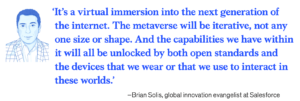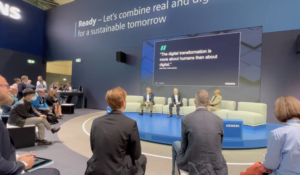
The future of broadcast is literally at our fingertips…
The living room is the epicenter of family, the hub of the household. Perhaps more so than the dining table, the living room hosts hours upon hours of family attention and interaction every week. Whether we were gripped by the music and voices emitting from radios or entranced by the moving images illuminating our televisions, we celebrated everything from togetherness to relaxation around a common centerpiece.
This once mighty magnet of attention, through its iterative forms, is learning to share its powers of attraction forever changing the idea of the family cornerstone. Now attention is a battlefield and the laws of attraction are distributed.
Like passing ships in the night, the TV and the Internet have yet to intimately embrace one another. Instead, each are vying to become your center of attention. In reality however, you and I know that they’re already co-existing as people increasingly bring their laptops and iPads into the living room. When Forrester Research published a report that, for the first time, marked the equalization of time spent between TVs and the internet, it was and wasn’t a surprise. Indeed, it was inevitable. Depending on where you reside in the adoption bell curve, this news is either overdue or early. Either way, it’s both a culture shift and shock. If for but a moment, these two ships are frozen, floating across from each other without obstructing the respective course. However, the wakes cast through each journey to this point are felt on both sides.
Change lies ahead and how it looks and what it means are unclear and debatable. But, what’s not in question is its importance and consequence.
If you are in the business of trying to reach consumers to earn attention, your world no longer rotates on its previous axis. Progressive brands are already experimenting with media and corresponding budgets to capture attention where and when it’s focused. For example, Proctor & Gamble is moving spend away from TV soaps and daytime dramas toward digital and social channels. This move signals the beginning of the end of an era and also the beginning of the end of business as usual.
This is None of Your Business…So Make It Your Business
Forrester surveyed over 40,000 people and if for nothing else, the findings serve as evidence necessary to turn our wheel and change course. Three short years ago, only one-third of Americans shopped online. Now, two-thirds rely on e-commerce to shop. Comparatively, 35 percent of respondents visit social networks today, up from 15 percent in 2007. Like e-commerce, we can make an educated guess as to where that number will climb three years from now.
The proliferation of the Internet is far more disruptive than we realize. It seems as though decades and in some cases centuries of media production and consumption are becoming obsolete overnight. As a good friend of mine said in reaction to Forrester’s controversial report, “I knew this would happen, but so soon…?”
Suddenly traditional media properties including newspapers, broadcast radio and TV, magazines, et al, were caught off guard when the new media revolution hit. Suddenly everyone is turning to Facebook, Twitter, GoogleTV and the iPad as the savior for the future of all traditional media. But this revolution didn’t happen over night. For many years a quiet riot assembled until whispers amplified into cries for change. And when their pleas went unacknowledged or unaddressed, they, we, embraced the democracy of social media to ensure that our voices were heard.
For businesses and media properties, I’m sorry to say, social media, geo-location, and tablets aren’t going to save you. Thoughtfulness and empathy are the keys to unlock the gates that will lead you onto a new path of awareness. It’s the steps you take that reveal how to earn relevance within each medium that captivates your consumers.
I Want My Web TV
Sound familiar? The promise of a convergence between TVs and the Internet is ambiguous at best. New media isn’t going away. It’s always new and that’s the point. What’s clear is that for the time being, attention is equally divided between TVs and the internet.
Culturally, we already see the coalescence of these two activities. But, attention might not prove to be what it was. Continuous partial attention, while disputed, is something that is in play for the Twitterati, those highly dexterous individuals who can watch TV, live tweet the experience, and discuss it with friends in real-time. What if the living room becomes virtual, connected through individuals connected by a platform, time, and common interests. It’s no longer a matter of what if…this is the new reality TV and we are inserting ourselves into the production through live commentary viewable and searchable by those audiences who have willfully connected to us.
The water cooler is already moving to the PC and social is emerging as the long fabled catalyst for the overdue convergence of the TV and internet.
The future of broadcast is social. At the same time, the future of the internet is linked by shared experiences. As such, consumers will bring their mobile phones, tablets, and laptops to the digital living room to watch and share experiences and create a greater conversation and sense of belonging.
Producers will now increasingly create content that includes us in the event and the storyline. Architects of social and hardware platforms will need to rethink how TVs and the internet converge to foster consumption and engagement. And, those brands who subsidize content production, will have to transcend the practice of following attention to captivating it through innovation and experimentation.
The audience is not the audience of old. It’s now an audience with an audience of audiences. And I guess that’s where everything begins now. The people who used to sit in front of a television and talk about their experiences to friends, family and co-workers are now empowered to do so right here, right now. Perhaps more important however, people are building full-fledged networks around them, creating a distribution channel of audiences with audiences and their reach is as influential as it is infinite.
How will you steer experiences in the future?
Connect with Brian Solis on Twitter, LinkedIn, Facebook
![]()
___
If you’re looking for a way to FIND answers in social media, consider Engage!: Deluxe or Paperback

___
Get The Conversation Prism:

___
Image Credit: Shutterstock





Great article Brian, but I’d really like to see something from more than 50,000 feet. Who’s ahead of the curve in broadcast or in actual programming? How are they doing it? The pervasiveness of these social ‘chiclets’ or logos is funny to see at the wrapper of virtually every TV ad these days…is that the first step? Last night, Macy’s ran a whole ad dedicated to telling me to go to their Facebook page to do something. Would you say we’re less than 3 years out from not having to leave the living room couch to do that? Integrated tablet remote? How will the networks adapt!
Jon, indeed. More and more we’re seeing “follow us on Twitter and friend us on Facebook,” but I don’t believe that helps. Additionally, programs are now integrating viewers tweets and also real-time twitter trends into live broadcasts and also programming into scripts. But, I will share highlights once I finish the next book. I’m actually going to write a report on it. Cheers!
Excellent article, Brian. The next two sentences resonate particularly well with me: “Producers will now increasingly create content that includes us in the event and the storyline. Architects of social and hardware platforms will need to rethink how TVs and the internet converge to foster consumption and engagement.” We’ve seen wonderful examples of alternate reality games and cross-media participation drama like “The Truth About Marika” in the past. I don’t see too many similar disruptive initiatives yet, but I do see great opportunities for companies who enable and embrace the design and ‘consumption’ of cross-media collaborative experiences. What do you think keeps companies from fully embracing this ‘new’ kind of pervasive collaborative initiatives, both for entertainment and marketing? And when do you think that such immersive social initiatives will hit mainstream?
Very well thought out Brian! Enjoyed it! 🙂 I agree…the future will definitely hold more crossover and blending between mediums!
fantastic article! I’m totally agree with tweets addition to programing. The best way to watch WorldSeries is with twitter by your side.
Although I must confest I’m watching even less TV everyday. The last time I make some calculations, I was watching around 20min a day.
Maybe if we could have more integration with tweets, and interactive technology makes even more friendly to “learn more” about what’s happening on screen, it woud be more interesting to watch something 🙂
cheers,
@RolandoPeralta
Rolando, that’s the point. You’re the escaping “audience” and programs and networks need to keep you engaged literally
Great article and agreed that the future of broadcasting is social. I’m part of a team that has developed and deployed an iPad Twitter app (Tweex) that acts as a companion for watching TV and what we’ve noticed in our early research and also through monitoring social media activities is not just that people like talking about the TV shows, movies and events, it is that viewers almost demand it. The instant gratification of finding out dubious details like “Where can I get shoes like those?”, “What city was this filmed in?”, or “I wish they had more of that character on the show” are details that network advertisers can benefit from, writers can leverage and broadcasters can gage interest in a particular show or event.
What I would love to see broadcasters doing is more live tweeting during shows. This could include cast members or characters, writers, directors, athletes, etc.
Jon brought up some great points in his comments and I too am interested in learning more about how networks will adapt. I’m looking forward to reading more in your reports and of course in your book.
At the up coming NAB expo in Las Vegas VDS will unviel WATERCOOLER™ The First Rules Based Automated Social Media Tool for Television
@SarahOrman ABC1 TV show “Adam Hills in Gordon St Tonight” is live tweeting and integrating Twitter responses into the show’s comedy in a week to week 360 degree manner. Jokes come out of the audience, are broadcast on air and then the FB universe and Twittersphere respond and some of those responses end up back on the show and map future segments.
Broadcast’s future includes tweets for real-time programming involvement and sets the table for constant engagement. No matter the program, local or national, if you can sustain the contact beyond the live broadcast, you’re building brand value as well. Thanks for the thought-provoking article, Brian. Great, timely panel at SXSW.
Twitter and Facebook have definitely become an integral part of Television. First advertisements use to list their websites on the canvas, but now they have the Facebook or Twitter icon asking the audience to follow them.